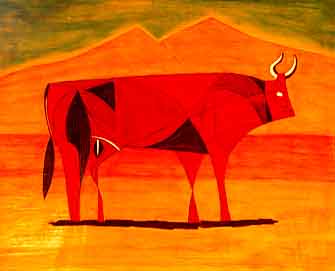This view of Coit Tower atop Telegraph Hill in San Francisco was my first work on canvas. The success of this piece led me to continue until I had completed nearly a hundred paintings on canvas.

'January 2, 1946, El Toro de Picasso': From December, 1945 to
January, 1946, Picasso did a series of lithographs starting
with a basic stick-figure bull and ending with a fully fleshed
out, beefy bull. I borrowed this image from the litho he did
on January 2, 1946, about midway through the series. This is a
"carved" canvas.

Here, you can see the carving stage is finished and the canvas
is ready to be painted.
Carved Canvases:
I developed a technique wherein I would cover a standard canvas with a texture paste, which is made by the same company that makes my paints. The paste, made of marble dust suspended in an acrylic polymer, is smeared onto the canvas, trowled smooth and allowed to dry. Before another layer is applied, the surface is scraped and sanded smooth.
When sufficient layers of paste had been applied to get a thickness of about a sixteenth of an inch, the first part of the painting is done. This usually required three or four layers of paste and four days to complete. I then draw the image in pencil onto the paste-covered canvas and carve it out using linoleum carving tools.
Using transparent acrylic paint, I layer one color over another, like red over blue or a light red over a dark red, to form a combination of colors and a deepness of hue. I then finish the painting with an acrylic gloss varnish. I call this method 'carved canvas' because the surface has a 3D quality to it. Many have remarked to me that they thought I was working on wood instead of canvas. They are surprised to learn the truth.
(I do not claim any credit for creating this technique but I have never seen anything like it anywhere else.)
Here is another example: This is a rendering of Modigliani's sketch of a seated woman. This is the exact same technique, except that it is a much lighter treatment. The "frame" is actually painted onto the mudded canvas.

The following two pieces are not carved:

'Archestraction, (After Charles Sheeler)' was borrowed from a painting by Charles Sheeler. I took the center portion of his work, expanded it and abstracted the heck out of it. 'Archistraction' is a series of works I did to abstract architectural images.

'Storm Over San Francisco' was taken from a photo I took from
a bus along Bridgeway in Sausalito. This work was commissioned by my good friend, Diane Boone, after I showed her some photos of my work. She wanted to buy the original, but I couldn't sell it, so I offered to do a new one for her. She was very pleased with the finished work.
Click on the PICASSO to return to my main page.






